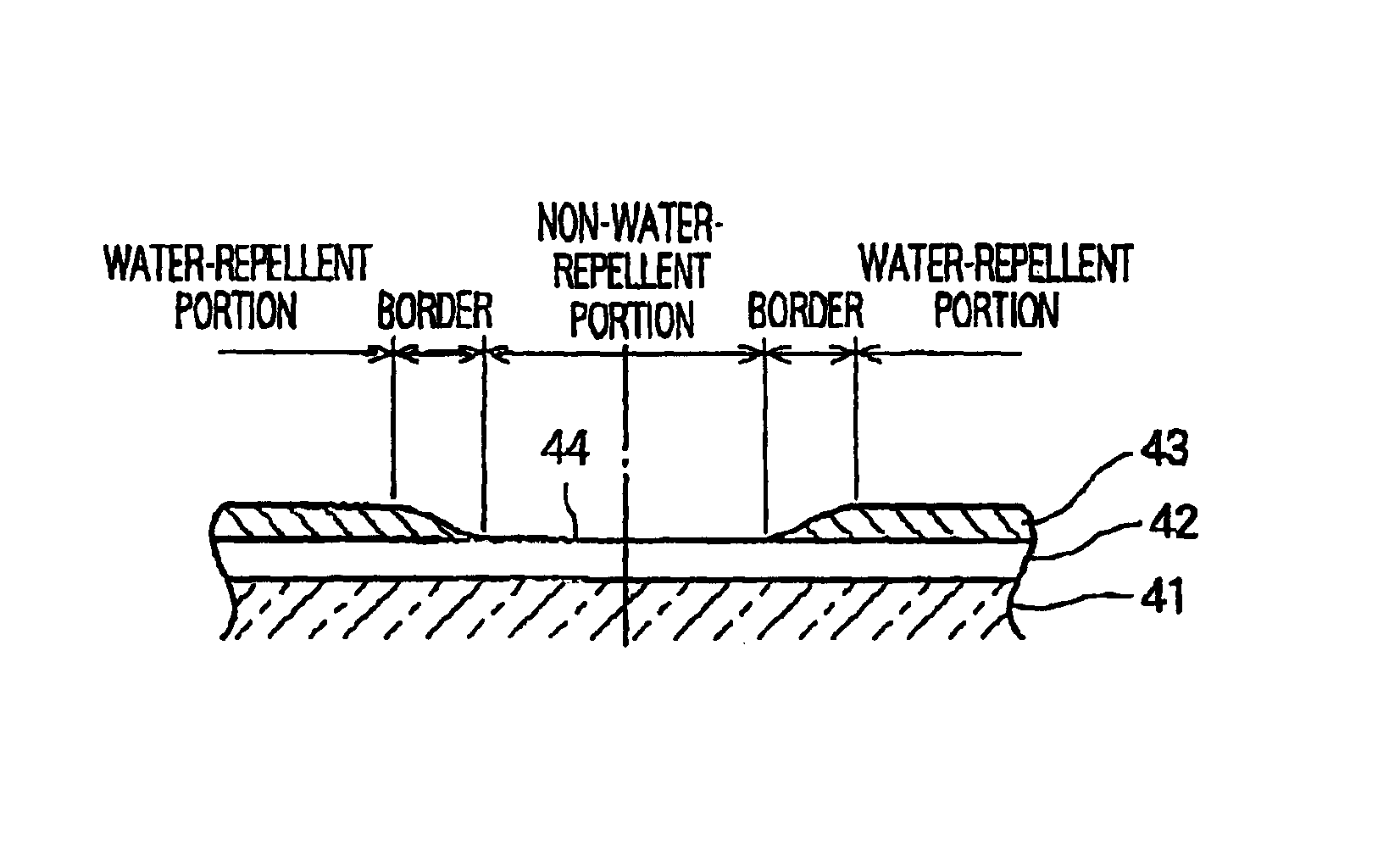Partially treated water-repellent glass sheet
a technology of water-repellent glass and glass panes, which is applied in the field of partially treating water-repellent glass sheets, can solve the problems of increasing the cost of water-repellent film processing, the inability of the holders to be attached to the water-repellent glass panes, and the inability to achieve the required adhesive strength between the adhesive and the glass pane, so as to achieve the effect of reducing production costs and increasing productivity
- Summary
- Abstract
- Description
- Claims
- Application Information
AI Technical Summary
Benefits of technology
Problems solved by technology
Method used
Image
Examples
example 1
[0057]EXPERIMENTAL EQUIPMENT: APPARATUS FOR TREATING FORMED PRODUCT WITH PLASMA JETS (available from COROTEC Corp.)[0058]SAMPLE: water-repellent glass sheet (including an undercoat of SiO2 having a thickness or 40 nm, and a water-repellent film of perfluoroalkylsilane having a thickness of 4 nm)[0059]DISTANCE H: 10 mm (See FIG. 3A)[0060]POWER: 0.5 kW for each plasma jet irradiation gun[0061]STRIKING VELOCITY OF PLASMA JETS (rate at which plasma jets impact upon a sample): about 7 m / s[0062]VELOCITY OF PLASMA JET IRRADIATION GUN (in movement parallel to the water-repellent glass sheet surface); 100 mm / sec[0063]TREATMENT: two times[0064]CONVERSION VELOCITY: 50 mm / sec[0065]EVALUATION: contact angle
[0066]FIG. 6 is a graph showing contact angles obtained from EXAMPLE 1. A horizontal axis shows the distance L (See FIG. 3B) from the center of the surface of the water-repellent glass sheet irradiated with plasma jets. A vertical axis shows contact angles θ. A contact angle θ is given between...
examples 2 to 4
[0068]EXPERIMENTAL EQUIPMENT: APPARATUS FOR TREATING FORMED PRODUCT WITH PLASMA JETS (available from COROTEC Corp.)[0069]SAMPLE: water-repellent glass sheet (including an undercoat of SiO2 having a thickness of 30 to 40 nm, and a water-repellent film or perfluoroalkylsilane having a thickness of 2 to 5 nm)[0070]DISTANCE H: 10 nm[0071]POWER: 0.5 kW for each plasma jet irradiation gun[0072]STRIKING VELOCITY OF PLASMA JET: about 7 m / s[0073]VELOCITY OF PLASMA JET IRRADIATION GM: 100, 20, and 120 nm / sec[0074]TREATMENT: four times or once
[0075]
TABLE 1EXAMPLEEXAMPLEEXAMPLEEXAMPLE1234DISTANCE H 10 mm 10 mm10 mm 10 mmVELOCITY100 mm / sec100 nm / sec10 mm / sec120 mm / secOF PLASMAJET IRRA-DIATIONGUNTREATMENTtwicefour timesonceonceCON- 50 mm / sec 25 mm / sec10 mm / sec120 mm / seeVERSIONVELOCITYEVAL-goodgoodgoodno goodUATION
[0076]CONVERSION VELOCITY=VELOCITY OF THE PLASMA JET IRRADIATION GUNNUMBER OF TIMES SAMPLE IS TREATED
[0077]In EXAMPLE 2, the velocity of the plasma jet irradiatio...
examples 5 to 7
[0084]EXPERIMENTAL EQUIPMENT: APPARATUS FOR TREATING FORMED PRODUCT WITH PLASMA JET (available from COROTEC Corp.)[0085]SAMPLE: water-repellent glass sheet (including an undercoat of SiO2 having a thickness of 30 to 40 nm, and a water-repellant film of perfluoroalkylsilane having a thickness of 2 to 5 nm) or a conventional glass sheet[0086]DISTANCE H: 10 mm[0087]POWER: 0.5 kW for each plasma jet irradiation gun[0088]STRIKING VELOCITY OF PLASMA JET: about 7 m / s[0089]VELOCITY OF PLASMA JET IRRADIATION GUN: 40 mm / sec[0090]TREATMENT: twice[0091]CONVERSION VELOCITY: 20 mm / sec
[0092]
TABLE 2EXAMPLEEXAMPLEEXAMPLE567Distance H10 mm10 mm10 mmVelocity of PlasmJet40 mm / s40 mm / s40 mm / sIrradiation GunTreatmenttwicetwicetwiceConversion Velocity20 mm / s20 mm / s20 mm / sTested Portionnon-water-water-surface ofrepellentrepellentconventionalportionportionglass sheetAdhesive Strength Fx80 kgf059 kgfAdhesive Strength FZ10 kg or010 kg or moremoreFailurecohesiveinterfacial failurecohesive failurefailure
[0093]I...
PUM
| Property | Measurement | Unit |
|---|---|---|
| velocity | aaaaa | aaaaa |
| distance | aaaaa | aaaaa |
| distance | aaaaa | aaaaa |
Abstract
Description
Claims
Application Information
 Login to View More
Login to View More - R&D
- Intellectual Property
- Life Sciences
- Materials
- Tech Scout
- Unparalleled Data Quality
- Higher Quality Content
- 60% Fewer Hallucinations
Browse by: Latest US Patents, China's latest patents, Technical Efficacy Thesaurus, Application Domain, Technology Topic, Popular Technical Reports.
© 2025 PatSnap. All rights reserved.Legal|Privacy policy|Modern Slavery Act Transparency Statement|Sitemap|About US| Contact US: help@patsnap.com



